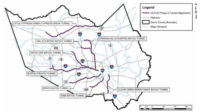A flood risk reduction program in Texas is seeking minority- and woman-owned small businesses in order to provide relief to low-to-moderate income communities in a flood-prone area.
The Halls Bayou Bond Implementation Program includes 14 projects planned to be built over the next five to seven years at an estimated cost of more than $400 million. Construction of two of the projects has already started, and bidding for another opened on Nov. 5 and will close on Nov. 29.
The area along the 20-mile bayou watershed in north-central Harris County, including part of Houston, has a long history of repeated flooding. Dena Green, planning department manager at the Harris County Flood Control District, says about 13,000 homes flooded along Halls Bayou as a result of Tropical Storm Allison in 2001, and 2017’s Hurricane Harvey flooded nearly 12,000 homes in the area. The watershed has faced 14 major floods since 1989, officials say.
A year after Hurricane Harvey, local voters passed a $2.5-billion bond program to fund hundreds of flood risk reduction projects. That bond election included a commitment to pursue outside partnership funding from state and federal agencies for a total planned program value of $5 billion, says Alan Black, interim executive director of the Flood Control District. However, as ENR previously reported, officials have faced some difficulty funding all the projects, facing a gap of as much as $1.4 billion across the district.
In order to find funding and help the Halls Bayou program run smoothly, the Flood Control District brought on Lockwood, Andrews & Newnam Inc. (LAN) as bond implementation manager. Hiring LAN helpfully turned the program “into a turnkey process,” as the District has faced a nearly tenfold increase in annual project cost size since the bond election, Black says.
“That is, for LAN to provide all of the staff and support to be able to provide every facet of the program management side,” he says. “We still engage with other professional services consultants for the final engineering design, but it’s all under the oversight of LAN. So it’s been a great way to move more work through the pipeline faster and to spread out the resources — because increasing that output by tenfold, there’s no one way to accomplish it all. It’s a combination of a lot of different approaches.”
Lars N. Zetterstrom, vice president at LAN, serves as the program manager for the Halls Bayou Bond Implementation. He says the team has turned to grant sources, such as the U.S. Dept. of Housing and Urban Development, which support minority- or woman-owned small businesses, or low-to-moderate income communities. Despite the area’s flooding history, it has historically not seen large scale improvements. That’s because traditional benefit-to-cost ratio analyses may not account for the greater difficulty people in those communities face when recovering from storms, Zetterstrom says.
“We have been successful in being awarded grant funds from different grant sources, but we’ve also seen that the fact that we are in a low-to-moderate income area does play a role in the justification for decisions to fund various grant sources,” he says. “What I think is great is that, while you have a plan, all plans need to be continuously updated and evolved, and look for alternate funding sources when necessary.”
So far, the county has awarded a $3.5-million contract to Hurtado Construction Co. to build a pair of detention basins, one north of Hopper Road and one between Little York Road and Langley Road. They’re designed to hold 200 acre-ft of stormwater.
The Flood Control District received a $6.3-million grant for the project, but with the winning bid coming in at a lower amount, Zetterstrom says the team is asking the state agency that awarded the grant to allow it to put the leftover money to work on another related project.
“With the remaining bond funds, we’re seeking permission to be able to select an engineer of record to design conveyance improvements between the two detention basins so we can utilize the residual grant funds to maximize the benefits to the people of Halls Bayou,” he says.
The work has faced some obstacles. Working in an area prone to flooding has demonstrated the need for the projects.
“When your construction and project area is temporarily inundated due to rain events, it does impact the project schedule and unfortunately cause some delays,” Zetterstrom says.
When LAN joined the program, the firm shifted the hydraulic modeling framework from a more narrow main stem approach to look at the watershed’s various tributaries in order to provide more accurate modeling. Green says the team has been able to look watershed-wide at drain functions as a system, rather than individual spot projects. That way, the projects are scheduled so there are no inadvertent negative effects after one is completed but another is still pending. They’ve also been able to coordinate with other Harris County agencies and the city of Houston on their projects along Halls Bayou tributaries.
“I find it exciting to have a program like this in the Halls Bayou watershed where we were able to get funding for so many projects and then have a dedicated team so they’re able to stay on top of all of that and be really efficient with their time and move these projects as quickly as possible,” she says.
The county also awarded a $5.9-million contract to Lecon Inc., which was recently acquired by Resource Environmental Solutions LLC, for the first phase of channel conveyance improvements and the construction of a 180-acre-ft stormwater detention basin along Aldine Mail Route Road. The flood district has about $20 million available for the project’s two phases, about $14.6 million of which is partnership funding, including a $9.5-million Community Development Block Grant for Disaster Recovery.
The next project, currently out to bid, calls for the construction of drainage improvements and a concrete storm box. More details are available on the Harris County online procurement portal. A pre-bid video conference will be held on Nov. 15 and bidding will close on Nov. 29.






Post a comment to this article
Report Abusive Comment